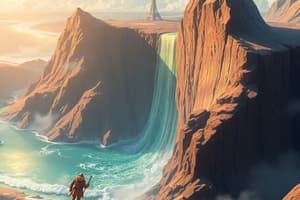Podcast
Questions and Answers
What geological feature forms at divergent plate boundaries as magma escapes into the space between the plates?
What geological feature forms at divergent plate boundaries as magma escapes into the space between the plates?
- Trench
- Rift valley (correct)
- Mountain range
- Subduction zone
What occurs when an oceanic plate collides with a continental plate?
What occurs when an oceanic plate collides with a continental plate?
- Seafloor spreading
- Rifting
- Volcanic eruption
- Subduction (correct)
Which feature is a well-known example of a ridge formed at a divergent boundary?
Which feature is a well-known example of a ridge formed at a divergent boundary?
- Rocky Mountains
- Andes Mountains
- Mid-Atlantic Ridge (correct)
- Himalayas
What does the process of seafloor spreading involve?
What does the process of seafloor spreading involve?
Which type of tectonic plate boundary is characterized by plates moving towards each other?
Which type of tectonic plate boundary is characterized by plates moving towards each other?
What geological phenomenon is most likely to occur along convergent plate boundaries?
What geological phenomenon is most likely to occur along convergent plate boundaries?
What is a characteristic of magma compared to solid rock?
What is a characteristic of magma compared to solid rock?
What force is primarily responsible for the movement of tectonic plates?
What force is primarily responsible for the movement of tectonic plates?
What is the purpose of the Richter scale in relation to earthquakes?
What is the purpose of the Richter scale in relation to earthquakes?
What happens for every 1-point increase on the Richter scale?
What happens for every 1-point increase on the Richter scale?
Which of the following best describes a transform boundary?
Which of the following best describes a transform boundary?
What are the two types of seismic waves mentioned?
What are the two types of seismic waves mentioned?
What occurs when two oceanic plates collide?
What occurs when two oceanic plates collide?
What is the focus of an earthquake?
What is the focus of an earthquake?
What is the characteristic of a divergent boundary?
What is the characteristic of a divergent boundary?
How do the colliding continental plates affect the Earth's surface?
How do the colliding continental plates affect the Earth's surface?
Flashcards are hidden until you start studying
Study Notes
Earthquakes
- The Richter Scale measures earthquake magnitude, with larger numbers indicating stronger earthquakes.
- Each whole number increase on the Richter scale represents a tenfold increase in ground shaking and a 32-fold increase in energy released.
- Earthquakes are often caused by plates sliding past each other at transform boundaries, such as the San Andreas Fault in California.
- Seismic waves are vibrations that travel outward from the focus, the point where an earthquake's energy is released.
- The epicenter is the point on Earth's surface directly above the focus.
Plate Tectonics
- Plate tectonics is the theory explaining the movement of Earth's lithospheric plates.
- The lithosphere is composed of the crust and upper mantle, and floats on the partially molten asthenosphere.
- Plate boundaries are where plate interactions occur, leading to various geological features.
Types of Plate Boundaries
- Divergent boundaries occur when plates move apart, allowing magma to rise and form new crust. This process is responsible for mid-ocean ridges, rift valleys, and volcanic activity.
- Convergent boundaries occur when plates collide, resulting in subduction, where one plate sinks beneath another. This process leads to volcanoes, earthquakes, and mountain ranges.
- Transform boundaries occur when plates slide past each other, causing earthquakes and faults.
Seafloor Spreading
- Seafloor spreading is the process by which new oceanic crust is created at mid-ocean ridges and spreads away from the ridge.
- Basalt, a type of igneous rock, is formed as magma rises and cools along mid-ocean ridges.
Convection Currents
- Convection currents in the Earth's mantle are driven by uneven heating, creating a cycle of hot, less dense material rising and cooler, denser material sinking.
- These convection currents are responsible for the movement of tectonic plates.
Studying That Suits You
Use AI to generate personalized quizzes and flashcards to suit your learning preferences.




